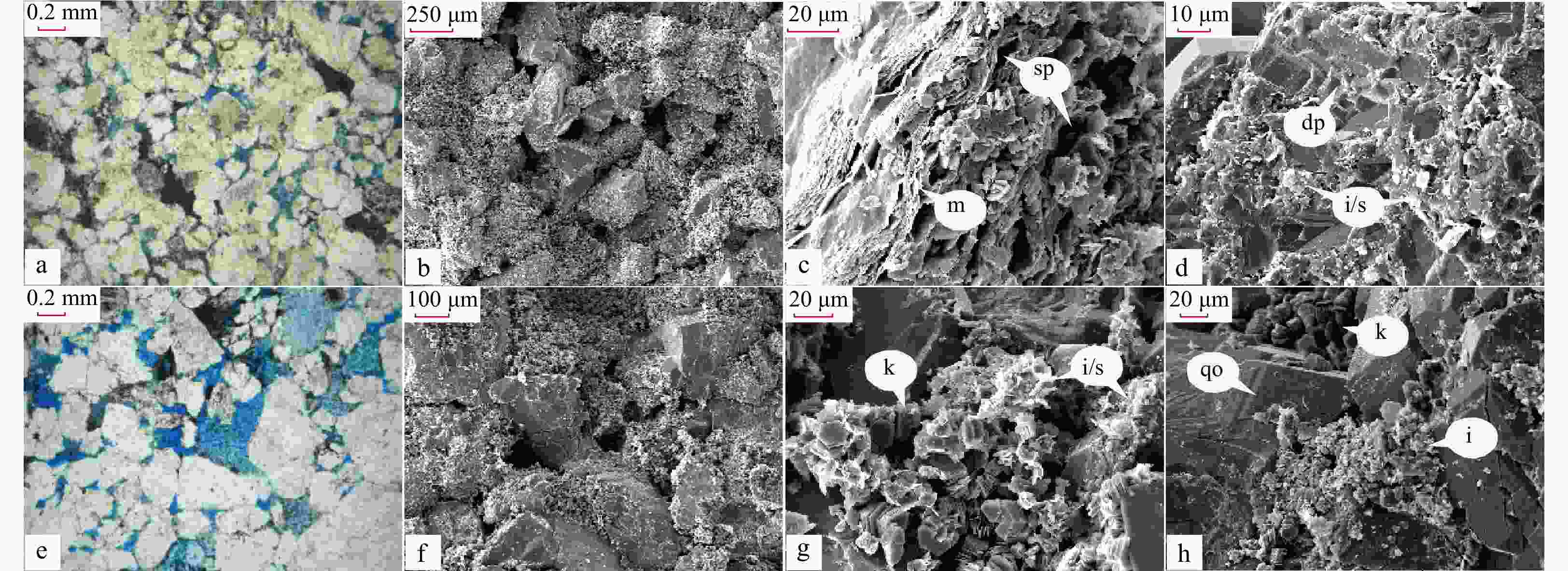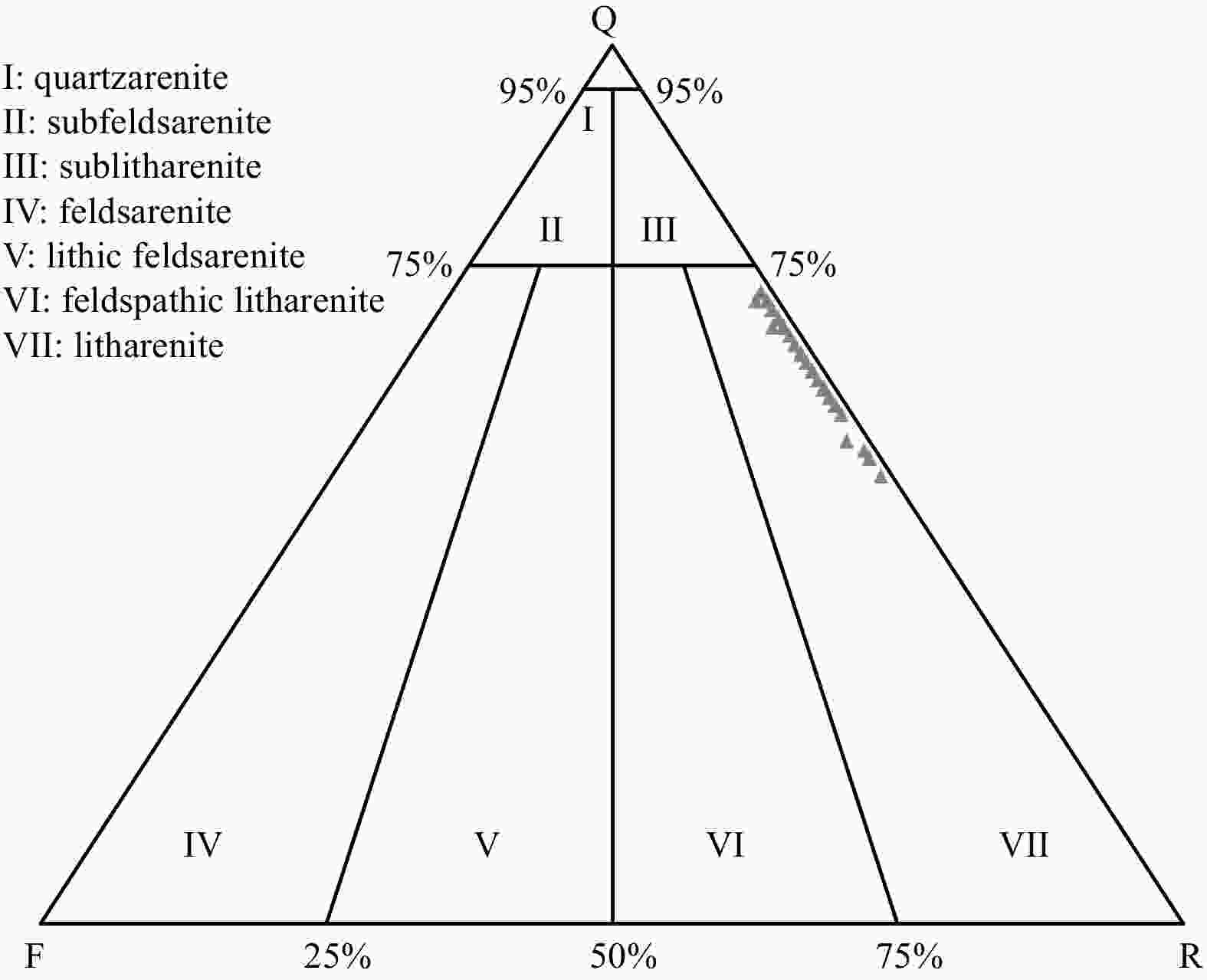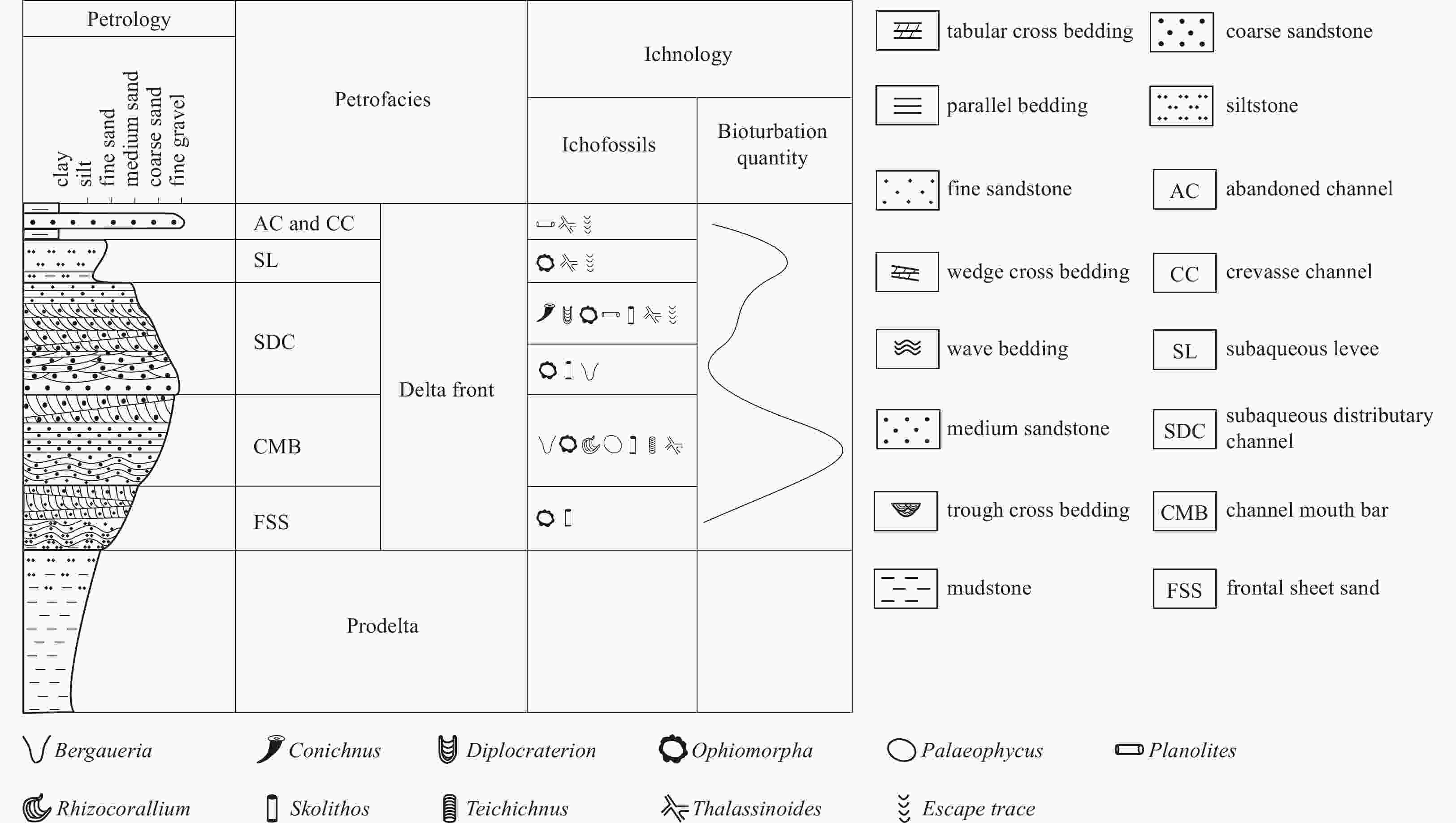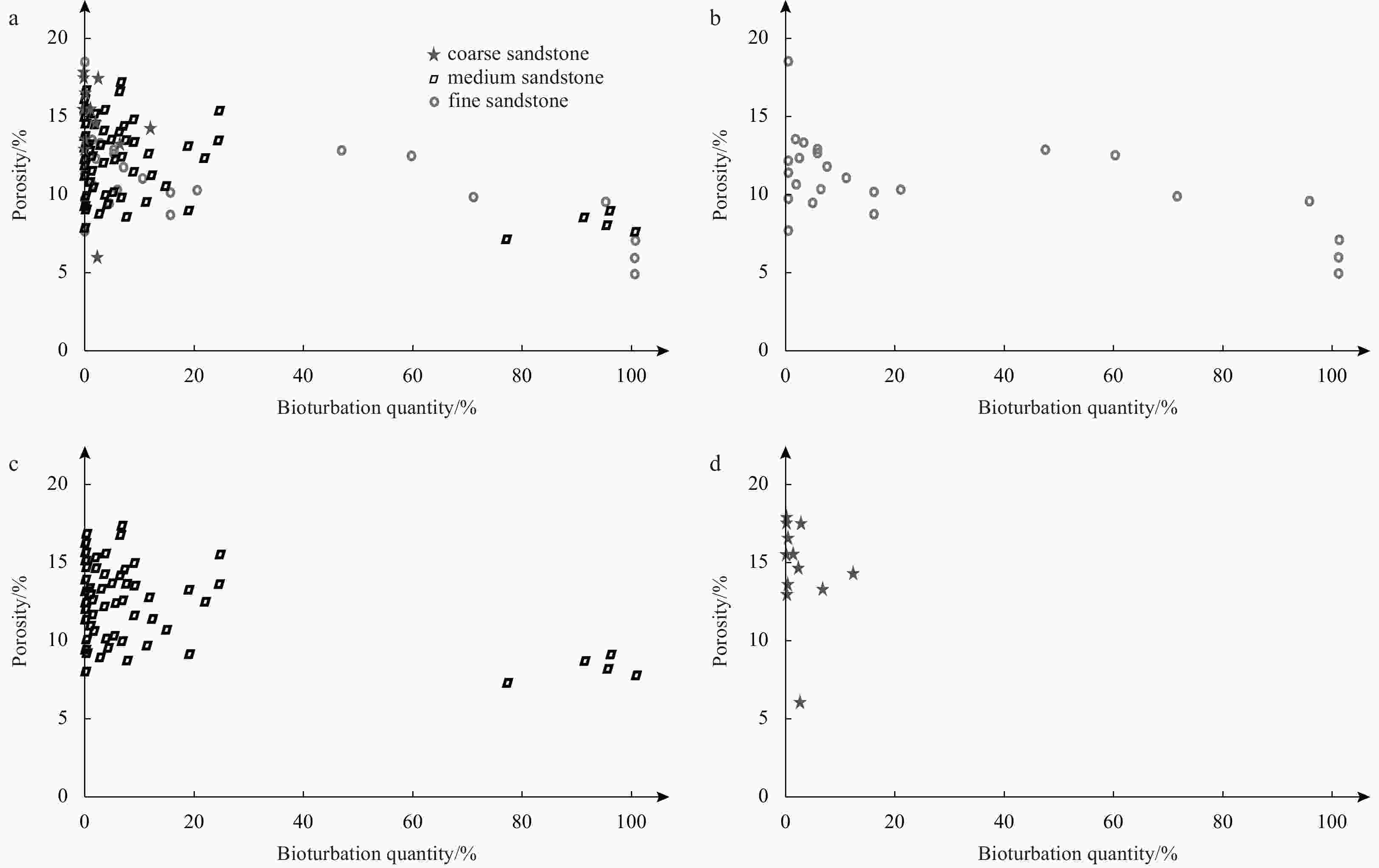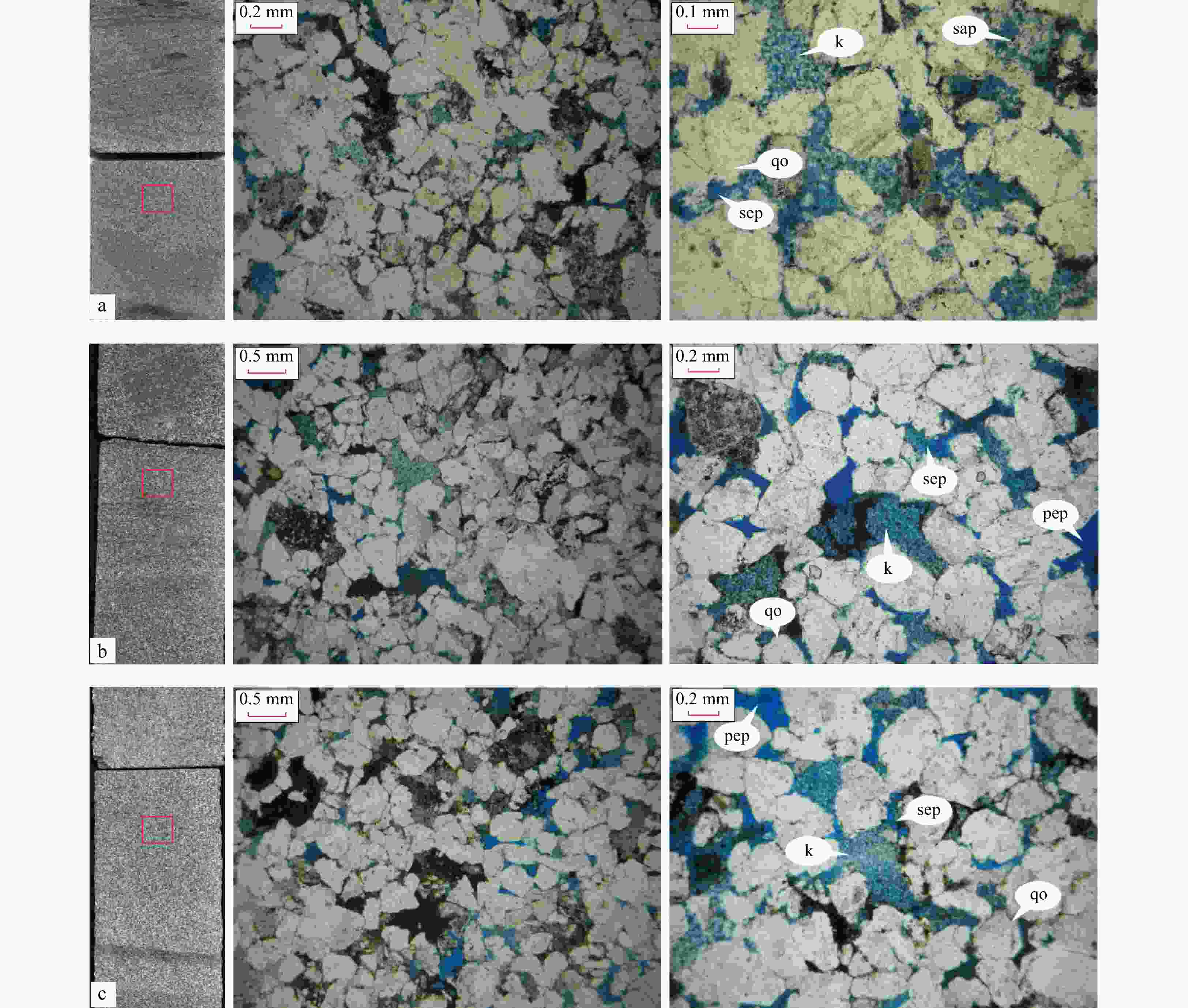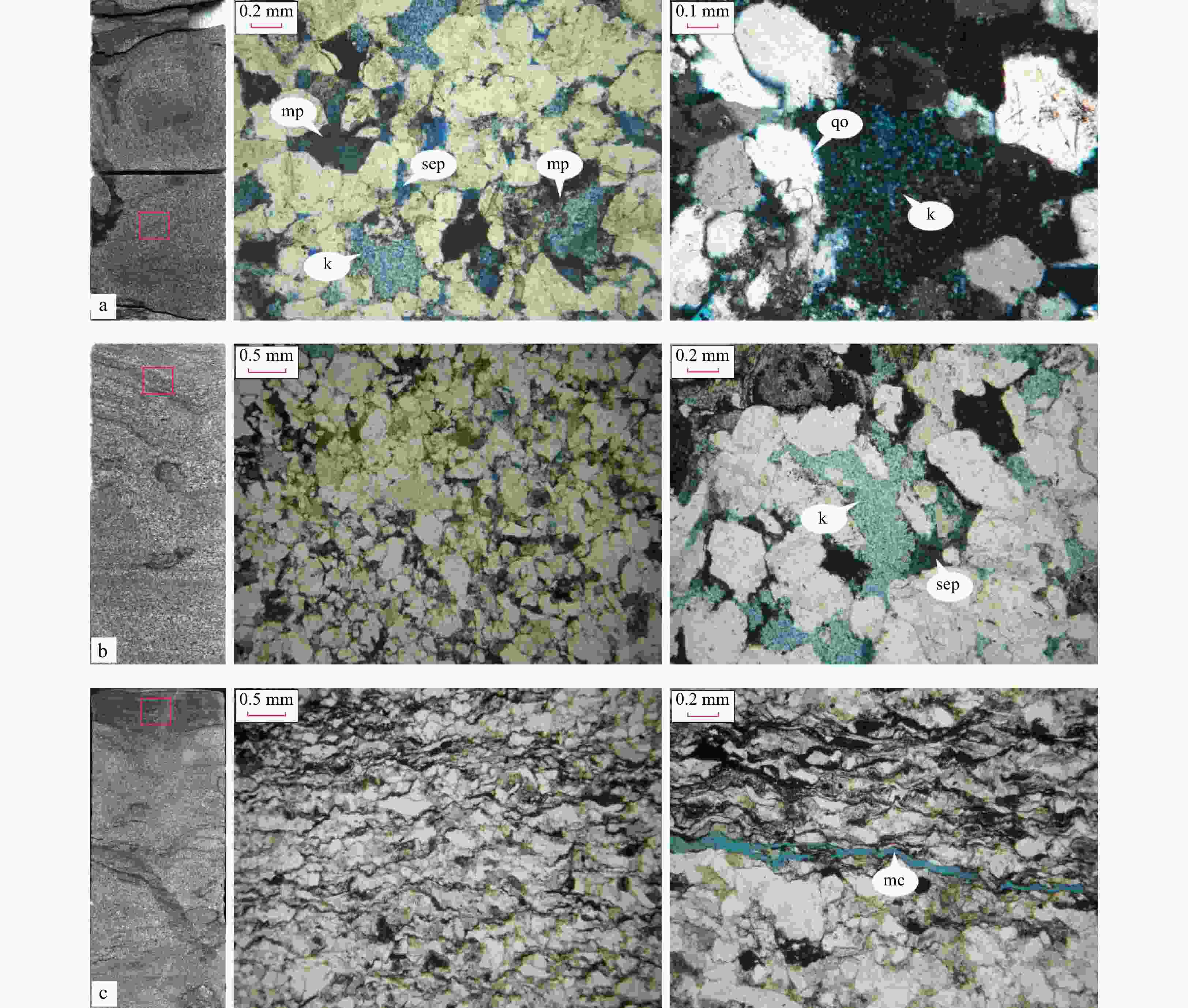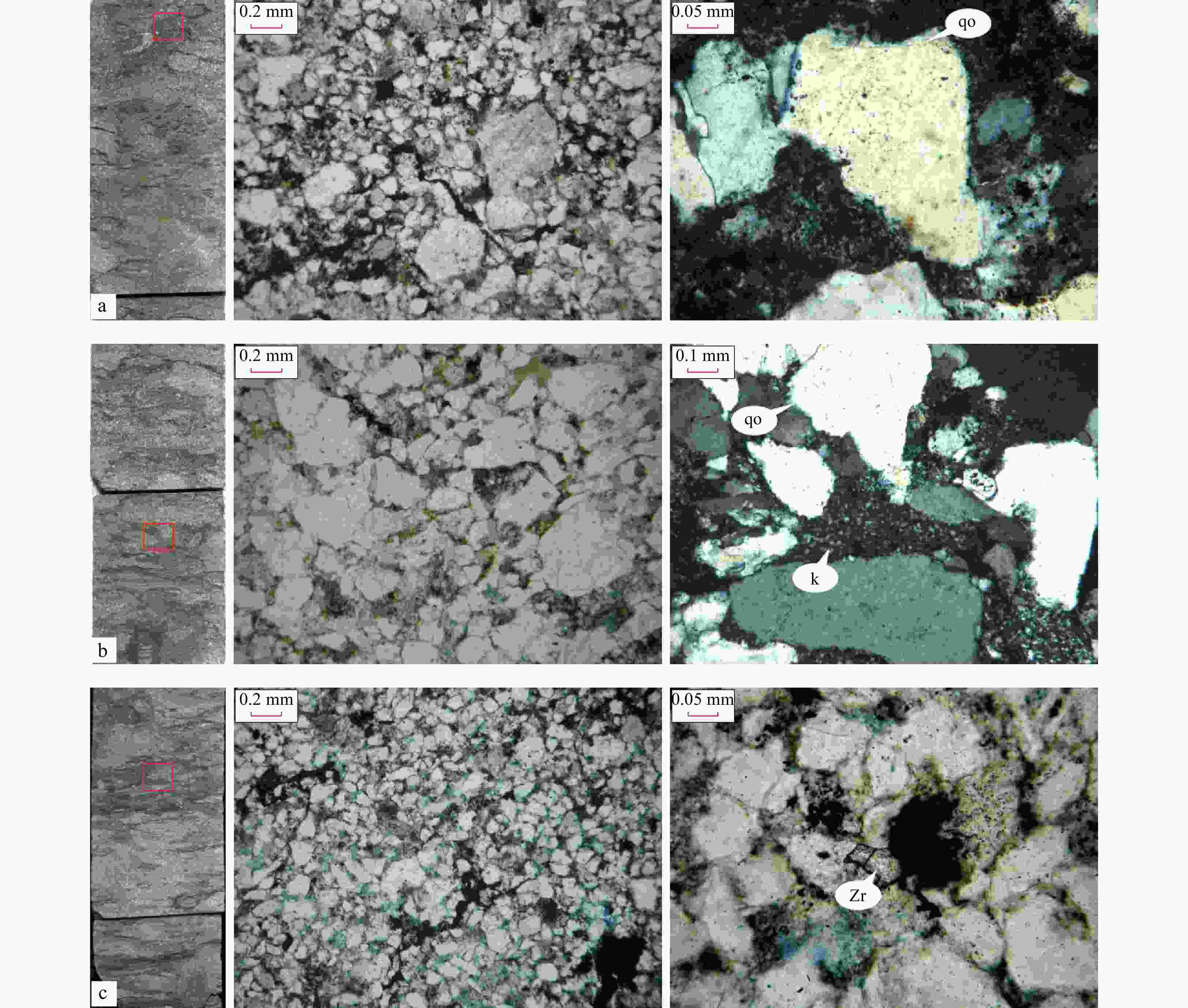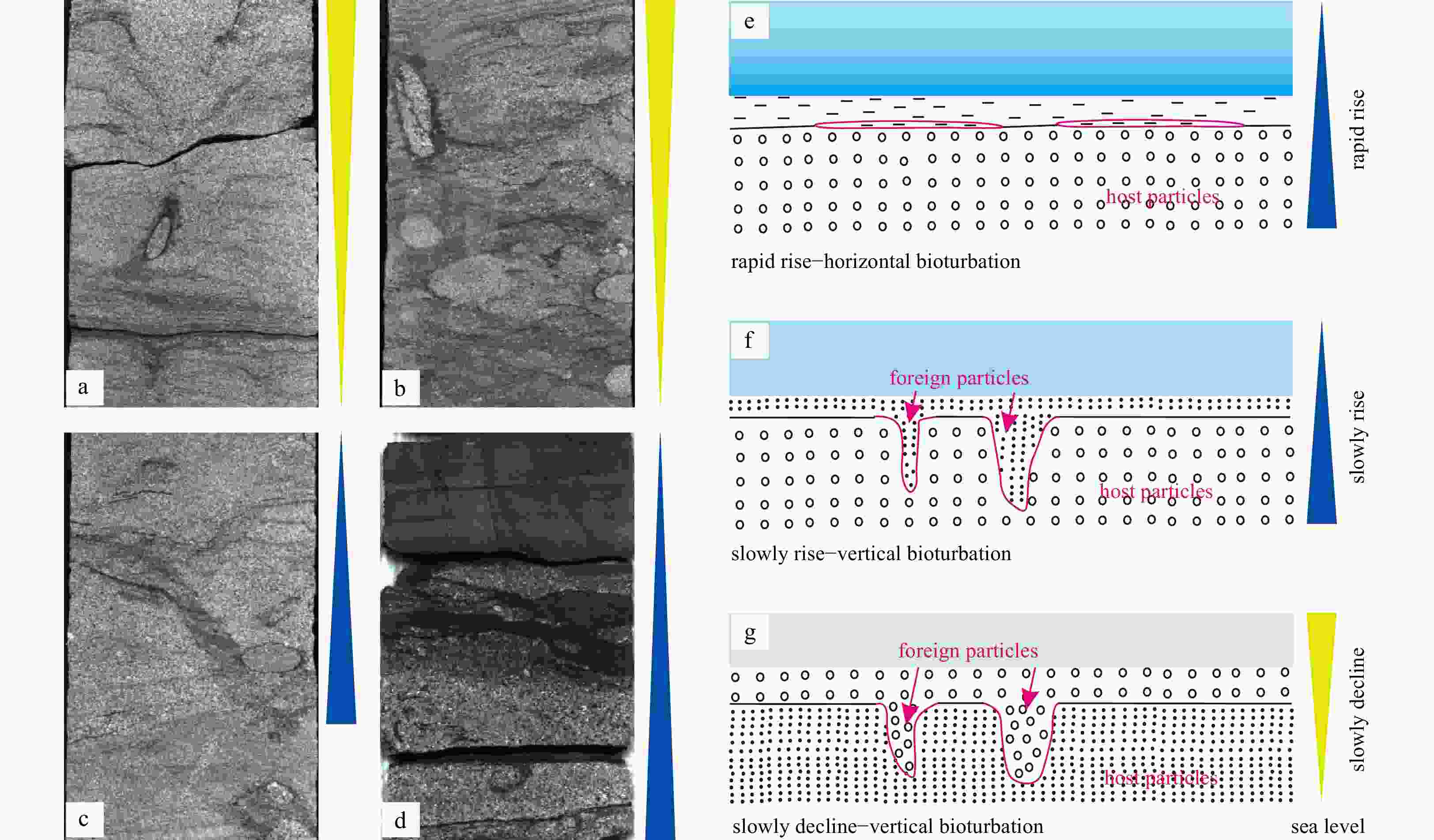The influence of bioturbation on sandy reservoirs: the delta front sand of the lower Zhujiang Formation, Baiyun Depression, Zhujiang River Mouth Basin
-
Abstract: Ichnofossils are well developed in clastic rock reservoirs in marine and transitional facies, which can considerably change the physical properties of the reservoir. However, this influence is not well understood, raising an important problem in the effective development of petroleum reservoirs. This paper analyzes continental shelf margin delta reservoirs through core observation, cast thin section observation and reservoir physical property test. Some important scientific insights are obtained: (1) The presence of Cruziana ichnofacies, including Asterosoma, Ophiomorpha, Planolites, Skolithos, Thalassinoides, and other ichnofossils can be used to identify in subaqueous distributary channels, subaqueous levee, frontal sheet sand, abandoned river channels, crevasse channels, main channels and channel mouth bars. Considerable differences in the types of ichnofossils and the degree of bioturbation can be observed in the different petrofacies. (2) Ichnofossils and bioturbation play a complex role in controlling reservoir properties. The reservoir physical properties have the characteristics of a decrease–increase–decrease curve with increasing bioturbation degree. This complex change is controlled by the sediment mixing and packing of bioturbation and the diagenetic environment controlled by the ichnofossils. (3) Sea-level cycle changes affect the modification of the reservoir through sediment packing. Bioturbation weakens the reservoir’s physical property when sea level slowly rises and improves the reservoir’s physical property when base level slowly falls.
-
Key words:
- bioturbation /
- reservoir physical properties /
- sedimentary petrofacies /
- shelf margin delta /
- Baiyun Sag
-
Figure 2. Schematic summary of the depositional evolution, sequence stratigraphy framework, and main tectonic movements in the Zhujiang River Mouth Basin during the Cenozoic period (modified from Lin et al. (2018a), SQhj3: Sequence Hangjiang Fm. 3; SQzj4: Sequence Zhujiang Fm. 4; SQzh2: Sequence Zhuhai Fm. 2.
Figure 3. Micrograph of sandstone sample. a–d. Micrograph of the sandstone sample at depth of 3 735.03 m; a. Thin section image, the sample is a medium-fine grained sandstone, where the rock is compact; b. SEM image, overall, the intergranular pores are 30–100 μm with good connectivity; c. SEM image, feldspar is altered into flaky mica (m) and solution pores (sp); d. SEM image, quartz is dissolved into dissolution pits (dp) mixed with lamellar illite/smectite (i/s) layer. e–h. Micrograph of the sandstone sample at depth of 3 742.28 m; e. Thin section image, the sample is a medium-grained sandstone, where the rock is compact; f. SEM image, overall, the intergranular pores are 20–60 μm with good connectivity; g. SEM image, intergranular lamellar illite/smectite (i/s) mixed layer and kaolinite (k); h. SEM image, intergranular flaky illite (i), kaolinite (k), quartz overgrow (qo) to Level III.
Figure 6. Sedimentary characteristics of petrofacies. a–d. Sedimentary characteristics of subaqueous distributary channel. a. 3 735.33–3 735.50 m, fine-, medium-, to coarse-grained sandstone with tabular cross-bedding in the upper part. Conichnus (Co), Ophiomorpha (Op), and escape trace (e.t.) are contained near the scour surface. b. 3 742.83–3 743.00 m, medium- to coarse-grained massive sandstone with Thalassinoides (Th). c. 3 746.00–3 746.16 m, medium- to coarse-grained sandstone with massive bedding with Diplocraterion (Di), Ophiomorpha (Op), Skolithos (Sk), and Thalassinoides (Th). d. 3 750.31–3 750.45 m, fine-, medium- to coarse-grained sandstone, with parallel bedding in the upper part and small cross-bedding in the lower part. e–h. Sedimentary characteristics of the channel mouth bar. e. 3 732.86–3 733.04 m, fine- to medium-grained sandstone with fine gravel with Ophiomorpha (Op), Palaeophycus (Pa), andThalassinoides (Th). f. 3 745.54–3 745.68 m, fine-grained sandstone at the bottom, muddy stripe thereon, and scour surface at the top. g. 3 746.81–3 746.93 m, fine- to medium-grained sandstone with Ophiomorpha (Op), Palaeophycus (Pa), Rhizocorallium (Rh), and Skolithos (Sk). h. 3 746.99–3 747.20 m, fine-grained sandstone with Skolithos (Sk) and Thalassinoides (Th) and inverse graded bedding. i. Sedimentary characteristics of the abandoned channel and crevasse channel, 3 737.39–3 737.63 m; the bottom is gray coarse-grained sandstone with fine gravel of the crevasse channel, with discontinuous muddy lamination and escape trace (e.t.). Above it is the development of dark gray mudstone with Planolites (Pl) and unidentified dwelling burrows (dw) filled with medium- to coarse-grained sand. The top is a thin layer of silty sandstone in the abandoned channel with ripple cross lamination and Thalassinoides (Th) filled with medium-grained sand. j. Sedimentary characteristics of the frontal sheet sand, 3 739.30–3 739.45 m, fine- to medium-grained sandstone with inverse graded bedding and Ophiomorpha (Op). k. Frontal sheet sand, 3 739.56–3 739.68 m, contained Ophiomorpha (Op) and Thalassinoides (Th). l. Sedimentary characteristics of the subaqueous levee, 3 753.51–3 753.67 m, the lower is siltstone and fine-grained sandstone with muddy laminae and Ophiomorpha (Op), Thalassinoides (Th), escape trace (e.t.), the upper is fine- to medium-grained sandstone.
Figure 9. Relationship between bioturbation quantity and porosity. a. Relationship between bioturbation quantity and porosity in Well PY-X; b. relationship between bioturbation quantity and porosity of fine-grained sandstone samples; c. relationship between bioturbation quantity and porosity of medium-grained sandstone samples; d. relationship between bioturbation quantity and porosity of coarse-grained sandstone samples.
Figure 11. Thin-sectioned characteristics of sandstone samples with NBT or WBT. a. 3 736.03 m, medium- to fine-grained sandstone, medium sorting degree, point-line contact, contact-porous cementation type. Particles are mainly fine-grained sands, and some are medium- and very fine-grained sands. The pores are moderately developed and are distributed uniformly. The secondary is the main type, including secondary inter-granular pores (sep), secondary intra-granular pores (sap), and mold pores. The pore shape is irregular and the size is generally between 0.10 mm and 0.25 mm. The shape of the primary intergranular pores is mainly triangular and irregular, and the size is generally between 0.05 mm and 0.15 mm. Kaolinite (k) and quartz overgrow (qo) can be observed. b. 3 750.78 m, medium- to fine-grained sandstone, medium sorting degree, point-line contact, contact-porous cementation type. Particles are mainly medium-grained sand, some are coarse-grained sand and a small amount of fine-grained sand. The pores are mainly secondary pores with the inhomogeneous distribution. Their types are mainly secondary intergranular (sep) and granular dissolving pores with irregular shapes that have a general size of 0.15 mm and 0.40 mm. Primary intergranular pores (pep) are scarce. Kaolinite (k) and quartz overgrow (qo) can be observed. c. 3 756.28 m, medium- to coarse-grained sandstone, medium to a poor sorting degree, point-line contact, contact-porous cementation type. Particles are mainly medium- and coarse-grained sand. The pores are generally well developed. The pores are mainly secondary pores, including mold pores and secondary intergranular pores (sep). The pore shape is mainly irregular, and the size is generally between 0.15–0.60 mm. The shape of the primary intergranular pores (pep) is mainly triangular and irregular, and the size is generally 0.10–0.20 mm. Kaolinite (k) and quartz overgrow (qo) can be observed.
Figure 12. Thin-sectioned characteristics of sandstone samples with MBT. a. 3 735.53 m, medium- to coarse-grained sandstone, poor to medium sorting degree, point-line contact, and contact-pore cementation type. The amount of medium-grained sand particles is slightly higher than that of coarse-grained sand particles and small amounts of fine-grained sand particles also occur. The pores are moderately developed and uniformly distributed. The secondary pores, including mold pores (mp) and secondary intergranular pores (sep), represents the most common kind of pore. The shape of the secondary intergranular pores is irregular and their size is generally between 0.10–0.25 mm. Kaolinite (k) and quartz overgrow (qo) can be observed. b. 3 743.78 m, medium- to coarse-grained sandstone, poor to medium sorting degree, point-line contact, porous cementation type. The amount of medium-grained sands particles is slightly higher than that of coarse-grained sand particles, and a small amount of fine-grained sand praticles can also be observed. The pores, mainly secondary pores, are poorly developed and uniformly distributed, such as secondary intergranular pores (sep). The shape is irregular, and the size is generally between 0.10–0.30 mm. The primary pores are mainly intergranular pores with poor connectivity. Kaolinite (k) can be observed. c. 3 746.80 m, medium- to fine-grained sandstone, poor to medium sorting degree, concavo-convex contact, and porous cementation type. The amount of fine-grained sand particles is slightly higher than that of medium-grained sand particles, and a small amount of coarse-grained sand particles can also be observed. Microcracks (mc) can occasionally be observed with widths of 0.03–0.05 mm.
Figure 13. Thin-sectioned characteristics of sand samples with severe bioturbation from various ichnogenus. a. 3 732.07 m, medium- to fine-grained sandstone, poor to medium sorting degree, point-line contact, and porous cementation type. Fragment particles are mainly silty and fine-grained sands, with fewer medium-grained particles. The pores are poorly developed, distributed in homogeneously, and are mainly secondary dissolved pores with poor connectivity. Quartz overgrow (qo) can be observed. b. 3 732.53 m, medium- to fine-grained sandstone, poor sorting degree, point-line contact, and porous cementation type. Particles are contained in all grades, including fine-, medium-, and coarse-grained. Pores are poorly developed and granular and intergranular dissolved pores can occasionally be observed with poor connectivity. Kaolinite (k) and quartz overgrow (qo) can be observed. c. 3 747.66 m, fine-grained sandstone, medium to a good sorting degree, point-line contact, porous cementation type. Particles are mainly fine-grained with a small amount of medium-grained sands. The pores are poorly developed. Zircon (Zr) can occasionally be observed.
Table 1. Bioturbated classification scheme
BI Taylor and Goldring (1993) Droser and Bottjer (1986) This research scheme (modified from
Droser and Bottjer (1986))Bioturbated
quantity/%Classification Bioturbated
quantity/%Classification Bioturbated
quantity/%Classification 0 0 no-bioturbation 0 non-bioturbation 0 non-bioturbation 1 1–4 sparse bioturbation 0–10 discrete, isolated trace fossils 1–20 weakly bioturbated, massive,
parallel and tabular cross bedding
distinct boundaries and low
discrete traces density2 5–30 low bioturbation 10–40 burrows are generally isolated,
but locally overlap21–60 moderately bioturbated, massive
and parallel bedding with sharp
boundaries and rare discrete
traces overlap3
31–60
moderate bioturbation 40–60 burrows overlap and are not
always well defined4 60–90 high bioturbation 60–100 bedding is completely disturbed,
but burrows are still discrete in
places and the fabric is not mixed61–100 pervasively bioturbated, massive and inverse graded structures with indistinct to completely disturbed bedding boundaries, high trace density with common overlap to repeated overprinting 5 91–99 intense bioturbation 6 100 complete bioturbation 100 bedding is nearly or
totally homogenizedNote: BI: bioturbation index. -
Al-Hajeri M M, Al Saeed M, Derks J, et al. 2009. Basin and petroleum system modeling. Oilfield Review, 21(2): 14–29 Ali S A, Clark W J, Moore W R, et al. 2010. Diagenesis and reservoir quality. Oilfield Review, 22(2): 14–27 Angulo S, Buatois L A. 2012. Integrating depositional models, ichnology, and sequence stratigraphy in reservoir characterization: The middle member of the Devonian-Carboniferous Bakken Formation of subsurface southeastern Saskatchewan revisited. AAPG Bulletin, 96(6): 1017–1043. doi: 10.1306/11021111045 Baniak G M, Gingras M K, Burns B A, et al. 2015. Petrophysical characterization of bioturbated sandstone reservoir facies in the Upper Jurassic Ula Formation, Norwegian North Sea, Europe. Journal of Sedimentary Research, 85(1): 62–81. doi: 10.2110/jsr.2015.05 Baniak G M, Gingras M K, Pemberton S G. 2013. Reservoir characterization of burrow-associated dolomites in the Upper Devonian Wabamun Group, Pine Creek gas field, central Alberta, Canada. Marine and Petroleum Geology, 48: 275–292. doi: 10.1016/j.marpetgeo.2013.08.020 Bentley S J, Nittrouer C A. 2003. Emplacement, modification, and preservation of event strata on a flood-dominated continental shelf: Eel shelf, Northern California. Continental Shelf Research, 23(16): 1465–1493. doi: 10.1016/j.csr.2003.08.005 Buatois L A, Mángano M G. 2011. Ichnology: Organism-substrate Interactions in Space and Time. Cambridge: Cambridge University Press, 358 Catuneanu O, Galloway W E, Kendall C G St C, et al. 2011. Sequence stratigraphy: Methodology and Nomenclature. Newsletters on Stratigraphy, 44(3): 173–245. doi: 10.1127/0078-0421/2011/0011 Chen Changmin, Shi Hesheng, Xu Shice, et al. 2003. The Condition of Hydrocarbon Accumulation of Tertiary Petroleum System in Pearl River Mouth Basin (East) (in Chinese). Beijing: Science Press Chen Weitao, Du Jiayuan, Long Gengsheng, et al. 2012. Analysis on controlling factors of marine sequence stratigraphy evolution in Pearl River Mouth Basin. Acta Sedimentologica Sinica (in Chinese), 30(1): 73–83 Cunningham K J, Sukop M C, Huang Haibo, et al. 2009. Prominence of ichnologically influenced macroporosity in the karst Biscayne aquifer: Stratiform “super-K” zones. Geological Society of America Bulletin, 121(1−2): 164–180 Dasgupta S, Buatois L A, Mángano M G. 2016. Living on the edge: evaluating the impact of stress factors on animal-sediment interactions in subenvironments of a shelf-margin delta, the Mayaro Formation, Trinidad. Journal of Sedimentary Research, 86(9): 1034–1066. doi: 10.2110/jsr.2016.47 Dewhurst D N, Aplin A C, Sarda J P, et al. 1998. Compaction-driven evolution of porosity and permeability in natural mudstones: An experimental study. Journal of Geophysical Research: Solid Earth, 103(B1): 651–661. doi: 10.1029/97JB02540 Dewhurst D N, Aplin A C, Sarda J P. 1999. Influence of clay fraction on pore-scale properties and hydraulic conductivity of experimentally compacted mudstones. Journal of Geophysical Research: Solid Earth, 104(B12): 29261–29274. doi: 10.1029/1999JB900276 Dey J, Sen S. 2017. Impact of bioturbation on reservoir quality and production-a review. Journal of the Geological Society of India, 89(4): 460–470. doi: 10.1007/s12594-017-0629-4 Dirk K, Richard G B. 2012. Trace Fossils as Indicators of Sedimentary Environments. Amsterdam: Elsevier, 64: 105–129 Dixon J F, Steel R J, Olariu C. 2012. Shelf-edge delta regime as a predictor of deep-water deposition. Journal of Sedimentary Research, 82(9): 681–687. doi: 10.2110/jsr.2012.59 Dornbos S Q, Phelps W, Bottjer D J, et al. 2000. Effects of bioturbation on reservoir sandstone porosity and permeability: Studies of outcrop samples from the Upper Cretaceous, Book Cliffs, Utah (abs.). AAPG Annual Meeting Program 9, A40 Droser M L, Bottjer D J. 1986. A semiquantitative field classification of ichnofabric. Journal of Sedimentary Research, 56(4): 558–559. doi: 10.1306/212F89C2-2B24-11D7-8648000102C1865D Frey R W, Pemberton S G, Saunders T D A. 1990. Ichnofacies and bathymetry: a passive relationship. Journal of Paleontology, 64(1): 155–158. doi: 10.1017/S0022336000042372 Friesen O J, Dashtgard S E, Miller J, et al. 2017. Permeability heterogeneity in bioturbated sediments and implications for waterflooding of tight-oil reservoirs, Cardium Formation, Pembina Field, Alberta, Canada. Marine and Petroleum Geology, 82: 371–387. doi: 10.1016/j.marpetgeo.2017.01.019 Gerard J, Bromley R. 2008. Ichnofabrics in Clastic Sediments: Applications to Sedimentological Core Studies, a Practical Guide. Madrid: R. F. Gerard Gingras M K, Baniak G, Gordon J, et al. 2012. Porosity and permeability in bioturbated sediments. In: Developments in Sedimentology. Amsterdam: Elsevier, 64: 837–868 Gingras M K, Bann K L, MacEachern J A, et al. 2007. A conceptual framework for the application of trace fossils. In: MacEachern J A, Bann K L, Gingras M K, et al. , eds. SEPM Short Course Notes. Tulsa: Society of Economic Paleontologists and Mineralogists, 1–25 Gingras M K, MacEachern J A, Dashtgard S E. 2011. Process ichnology and the elucidation of physico-chemical stress. Sedimentary Geology, 237(3−4): 115–134. doi: 10.1016/j.sedgeo.2011.02.006 Hou Yuanli, Shao Lei, Qiao Peijun, et al. 2020. Provenance of the Eocene-Miocene sediments in the Baiyun Sag, Pearl River Mouth Basin. Marine Geology & Quaternary Geology (in Chinese), 40(2): 19–28 Hsieh A I, Allen D M, MacEachern J A. 2017. Upscaling permeability for reservoir-scale modeling in bioturbated, heterogeneous tight siliciclastic reservoirs: Lower Cretaceous Viking Formation, Provost Field, Alberta, Canada. Marine and Petroleum Geology, 88: 1032–1046. doi: 10.1016/j.marpetgeo.2017.09.023 Knaust D. 2009. Ichnology as a tool in carbonate reservoir characterization: a case study from the Permian-Triassic Khuff Formation in the Middle East. GeoArabia, 14(3): 17–38. doi: 10.2113/geoarabia140317 Knaust D. 2017. Atlas of Trace Fossils in Well Core: Appearance, Taxonomy and Interpretation. Gewerbestrasse: Springer, 13–24 La Croix A D, Gingras M K, Pemberton S G, et al. 2013. Biogenically enhanced reservoir properties in the Medicine Hat gas field, Alberta, Canada. Marine and Petroleum Geology, 43: 464–477. doi: 10.1016/j.marpetgeo.2012.12.002 La Croix A D, Maceachern J A, Ayranci K, et al. 2017. An ichnological-assemblage approach to reservoir heterogeneity assessment in bioturbated strata: Insights from the Lower Cretaceous Viking Formation, Alberta, Canada. Marine and Petroleum Geology, 86: 636–654. doi: 10.1016/j.marpetgeo.2017.06.024 Lemiski R T, Hovikoski D J, Pemberton D S G, et al. 2011. Sedimentological ichnological and reservoir characteristics of the low-permeability, gas-charged Alderson Member (Hatton gas field, southwest Saskatchewan): Implications for resource development. Bulletin of Canadian Petroleum Geology, 59(1): 27–53. doi: 10.2113/gscpgbull.59.1.27 Li Pinglu. 1993. Cenozoic tectonic movement in the Pearl River Mouth Basin. China Offshore Oil and Gas (Geology) (in Chinese), 7(6): 11–17 Li Dongyi, Chen Jian, Wang Aijun, et al. 2008. Recent progress in sediment transport research in Minjiang Estuary. Marine Science Bulletin (in Chinese), 27(2): 111–116 Li Xiaoping, Liu Baojun, Ding Lin, et al. 2016. Depositional elements definition of marine delta and significance to sand body correlation in petroleum exploration: From hydrodynamic analysis on modern Pearl River Delta. Acta Sedimentologica Sinica (in Chinese), 34(3): 555–562 Li Wenjing, Wang Yingmin, He Min, et al. 2018. Types and controlling factors of shelf margin delta of Middle Miocene in Pearl River Mouth Basin. Lithologic Reservoirs (in Chinese), 30(2): 58–66 Li Quan, Wu Wei, Liang Jianshe, et al. 2020. Deep-water channels in the lower Congo basin: Evolution of the geomorphology and depositional environment during the Miocene. Marine and Petroleum Geology, 115: 104260. doi: 10.1016/j.marpetgeo.2020.104260 Li Quan, Wu Wei, Yu Shui, et al. 2017. The application of three-dimensional seismic spectral decomposition and semblance attribute to characterizing the deepwater channel depositional elements in the Taranaki Basin of New Zealand. Acta Oceanologica Sinica, 36(9): 79–86. doi: 10.1007/s13131-017-1113-0 Li Yun, Zheng Rongcai, Yang Baoquan, et al. 2013. Provenance and its geological implications of Miocene Zhujiang Formation in Baiyun Sag, Pearl River Mouth Basin. Geological Review (in Chinese), 59(1): 41–51 Lin Changsong, He Min, Steel R J, et al. 2018a. Changes in inner- to outer-shelf delta architecture, Oligocene to Quaternary Pearl River shelf-margin prism, northern South China Sea. Marine Geology, 404: 187–204. doi: 10.1016/j.margeo.2018.07.009 Lin Changsong, Jiang Jing, Shi Hesheng, et al. 2018b. Sequence architecture and depositional evolution of the northern continental slope of the South China Sea: Responses to tectonic processes and changes in sea level. Basin Research, 30: 568–595. doi: 10.1111/bre.12238 Lin Changsong, Liu Jingyan, Cai Shixiang, et al. 2001. Depositional architecture and developing settings of large-scale incised valley and submarine gravity flow systems in the Yinggehai and Qiongdongnan basins, South China Sea. Chinese Science Bulletin, 46(8): 690–693. doi: 10.1007/BF03182838 Liu Entao, Wang Hua, Uysal I T, et al. 2017. Paleogene igneous intrusion and its effect on thermal maturity of organic-rich mudstones in the Beibuwan Basin, South China Sea. Marine and Petroleum Geology, 86: 733–750. doi: 10.1016/j.marpetgeo.2017.06.026 Liu Weiqing, Wu Wei, Qin Chenggang, et al. 2014. Analysis on the sandstone reservoir by SEM: A case study of the delta front sand body of Zhujiang Formation, Baiyun Sag. Journal of Chinese Electron Microscopy Society (in Chinese), 33(2): 117–122 MacEachern J A, Bann K L, Pemberton S G, et al. 2007. The ichnofacies paradigm: high-resolution paleoenvironmental interpretation of the rock record. In: SEPM Short Course Notes. Tulsa: Society of Economic Paleontologists and Mineralogists, 52: 27–64 MacEachern J A, Zaitlin B A, Pemberton S G. 1999. A sharp-based sandstone of the Viking Formation, Joffre Field, Alberta, Canada; criteria for recognition of transgressively incised shoreface complexes. Journal of Sedimentary Research, 69(4): 876–892. doi: 10.2110/jsr.69.876 Oliveira de Araújo O M, Aguilera O, Coletti G, et al. 2021. X-ray micro-computed tomography of burrow-related porosity and permeability in shallow-marine equatorial carbonates: A case study from the Miocene Pirabas Formation, Brazil. Marine and Petroleum Geology, 127: 104966. doi: 10.1016/j.marpetgeo.2021.104966 Pang Xiong, Chen Changmin, Peng Dajun, et al. 2008. Basic geology of Baiyun deep-water area in the northern South China Sea. China Offshore Oil and Gas (in Chinese), 20(4): 215–222 Pang Xiong, Chen Changmin, Shao Lei, et al. 2007. Baiyun Movement, a great tectonic event on the Oligocene-Miocene boundary in the Northern South China Sea and its implications. Geological Review (in Chinese), 53(2): 145–151 Pang Xiong, Yang Shaokun, Zhu Ming, et al. 2004. Deep-water fan systems and petroleum resources on the northern slope of the South China Sea. Acta Geologica Sinica (English Edition), 78(3): 626–631 Pemberton S G, Gingras M K. 2005. Classification and characterizations of biogenically enhanced permeability. AAPG Bulletin, 89(11): 1493–1517. doi: 10.1306/07050504121 Pemberton S G, MacEachern J A, Frey R W. 1992. Trace fossil facies models: environmental and allostratigraphic significance. In: Walker R G, James N P, eds. Facies Models: Response to Sea Level Change. Stittsville Ontario: Geological Association of Canada, 47–72 Pemberton S G, MacEachern J A, Gingras M K, et al. 2008. Biogenic chaos: Cryptobioturbation and the work of sedimentologically friendly organisms. Palaeogeography, Palaeoclimatology, Palaeoecology, 270(3–4): 273–279 Pemberton S G, MacEachern J A, Saunders T. 2004. Stratigraphic applications of substrate-specific ichnofacies: Delineating discontinuities in the rock record. Geological Society of London, 228(1): 29–62 Perov G, Bhattacharya J P. 2011. Pleistocene shelf-margin delta: Intradeltaic deformation and sediment bypass, northern Gulf of Mexico. AAPG Bulletin, 95(9): 1617–1641. doi: 10.1306/01271109141 Petter A L, Steel R J. 2006. Hyperpycnal flow variability and slope organization on an Eocene shelf margin, Central Basin, Spitsbergen. AAPG Bulletin, 90(10): 1451–1472. doi: 10.1306/04240605144 Porębski S J, Steel R J. 2003. Shelf-margin deltas: Their stratigraphic significance and relation to deepwater sands. Earth-Science Reviews, 62(3−4): 283–326. doi: 10.1016/S0012-8252(02)00161-7 Qi Yong’an. 1998. Relations between bioturbation structures and petrophysical properties of Donghe sandstone reservoirs in central Tarim. Oil and Gas Geology (in Chinese), 19(4): 318–320 Qi Yong’an, Wang Min, Zheng Wei, et al. 2012. Calcite cements in burrows and their influence on reservoir property of the Donghe Sandstone, Tarim Basin, China. Journal of Earth Science, 23(2): 129–141. doi: 10.1007/s12583-012-0238-5 Quaye J A, Jiang Zaixing, Zhou Xuewen. 2019. Bioturbation influence on reservoir rock quality: A case study of Well Bian-5 from the second member Paleocene Funing Formation in the Jinhu Sag, Subei Basin, China. Journal of Petroleum Science and Engineering, 172: 1165–1173. doi: 10.1016/j.petrol.2018.09.026 Ran Huaijiang, Lin Changsong, Zhu Xiaomin, et al. 2015. Deposit features and control factors of low stands in deep water areas of Neocene in the northern South China Sea. Special Oil & Gas Reservoirs (in Chinese), 22(3): 46–50 Rodríguez W, Buatois L A, Mángano M G, et al. 2018. Sedimentology, ichnology, and sequence stratigraphy of the Miocene Oficina Formation, Junín and Boyacá areas, Orinoco Oil Belt, Eastern Venezuela Basin. Marine and Petroleum Geology, 92: 213–233. doi: 10.1016/j.marpetgeo.2018.01.037 Seilacher A. 1967. Bathymetry of trace fossils. Marine Geology, 5(5–6): 413–428. doi: 10.1016/0025-3227(67)90051-5 Seilacher A. 2007. Trace Fossil Analysis. Berlin, Heidelberg: Springer, 1–226 Shao Lei, Lei Yongchang, Pang Xiong, et al. 2005. Tectonic evolution and its controlling for sedimentary environment in Pearl River Mouth Basin. Journal of Tongji University: Natural Science (in Chinese), 33(9): 1177–1181 Shao Lei, Pang Xiong, Chen Changmin, et al. 2007. Terminal Oligocene sedimentary environments and abrupt provenance change event in the northern South China Sea. Geology in China (in Chinese), 34(6): 1022–1031 Shi Hesheng, Liu Baojun, Yan Chengzhi, et al. 2010. Hydrocarbon accumulation conditions and exploration potential in Baiyun-Liwan deepwater area, Pearl River Month Basin. China Offshore Oil and Gas (in Chinese), 22(6): 369–374 Taylor A M, Goldring R. 1993. Description and analysis of bioturbation and ichnofabric. Journal of the Geological Society, 150(1): 141–148. doi: 10.1144/gsjgs.150.1.0141 Taylor A, Goldring R, Gowland S. 2003. Analysis and application of ichnofabrics. Earth-Science Reviews, 60(3–4): 227–259. doi: 10.1016/S0012-8252(02)00105-8 Tonkin N S, McIlroy D, Meyer R, et al. 2010. Bioturbation influence on reservoir quality: A case study from the Cretaceous Ben Nevis Formation, Jeanne d’Arc Basin, offshore Newfoundland, Canada. AAPG bulletin, 94(7): 1059–1078. doi: 10.1306/12090909064 Wan Qionghua, Liu Weixin, Luo Wei, et al. 2017. Reservoir quality differences and major factors controlling low-permeability reservoirs of Oilfield A in the Lufeng Sag, Pearl River Mouth Basin. Oil & Gas Geology (in Chinese), 38(3): 551–560 Wang Daifu. 2016. Petrological characteristics of Zhujiang Formation and its influence on reservoir physical properties in Baiyun Sag. Ground Water (in Chinese), 38(1): 193–194, 208 Wang Yongfeng, Wang Yingmin, Li Dong, et al. 2011a. Characteristics of the slope break zones and their controls on the depositional systems in the Pearl River Mouth Basin. Sedimentary Geology and Tethyan Geology (in Chinese), 31(3): 1–6 Wang Yongfeng, Wang Yingmin, Li Dong, et al. 2011b. Characteristics of reservoirs in the Pearl River Mouth Basin. Oil Geophysical Prospecting (in Chinese), 46(6): 952–960 Wu Shiguo, Han Qinghua, Ma Yubo, et al. 2009. Petroleum system in deepwater basins of the northern South China Sea. Journal of Earth Science, 20(1): 124–135. doi: 10.1007/s12583-009-0014-3 Wu Wei, Li Quan, Yu Jing, et al. 2018. The Central Canyon depositional patterns and filling process in east of Lingshui Depression, Qiongdongnan Basin, northern South China Sea. Geological Journal, 53(6): 3064–3081. doi: 10.1002/gj.3143 Wu Wei, Liu Weiqing, Lin Changsong, et al. 2014. Sedimentary evolution of the Lower Zhujiang Group continental shelf edge in the north slope of Baiyun Sag, Pearl River Mouth Basin. Acta Geologica Sinica (in Chinese), 88(9): 1719–1727 Wu Wei, Wang Guangxu, Liu Weiqing. 2023. Quantitative morphometric analysis of a deep-water channel in the Taranaki Basin, New Zealand. Acta Oceanologica Sinica, 42(5): 42–56. doi: 10.1007/s13131-022-2024-2 Wu Jingfu, Xu Qiang, Zhu Yanhe. 2010. Generation and evolution of the shelf-edge delta in Oligocene and Miocene of Baiyun Sag in the South China Sea. Earth Science-Journal of China University of Geosciences (in Chinese), 35(4): 681–690. doi: 10.3799/dqkx.2010.083 Xie Lihua, Lin Changsong, Dong Wei, et al. 2009. High-resolution sequence stratigraphy of Zhujiang Formation and Zhuhai Formation in Panyu low uplift of the Zhujiang River Mouth Basin. Geology in China (in Chinese), 36(2): 366–377 Xie Xinong, Ren Jianye, Wang Zhenfeng, et al. 2015. Difference of tectonic evolution of continental marginal basins of South China Sea and relationship with SCS spreading. Earth Science Frontiers (in Chinese), 22(1): 77–87 Xu Yong, Chen Guojun, Ma Ming, et al. 2016. Sedimentary characteristic and evolution of Late Oligocene to Early Miocene in Baiyun depression, Pearl River Mouth Basin. Coal Geology & Exploration (in Chinese), 44(3): 1–9 Xu Qiang, Wang Yingmin, Lü Ming, et al. 2011. Identification of the shelf margin delta in sequence stratigraphic frameworks and its significance: A case study of the Baiyun Sag, South China Sea. Oil & Gas Geology (in Chinese), 32(5): 733–742 Yi Xuefei, Zhang Changmin, Li Shaohua, et al. 2012. Identification marks and depositional model of the shelf-margin delta from NSQ2 of the Pearl River Mouth Basin, China. Journal of Chengdu University of Technology: Science & Technology Edition (in Chinese), 39(3): 257–261 Yin Jun, Zhang Shangfeng, Du Jiayuan, et al. 2011. Sequence stratigraphy of the Zhujiang Formation in the Panyu area of the Pearl River Mouth Basin. Special Oil & Gas Reservoirs (in Chinese), 18(3): 56–59 Yu Ye, Zhang Changmin, Zhu Rui, et al. 2019. Characteristics and main controlling factors of the shelf-edge delta of the lower member of Zhujiang Formation in the northern Baiyun Depression. Marine Geology & Quaternary Geology (in Chinese), 39(3): 28–39 Zhang Gongcheng. 2010. Tectonic evolution of deepwater area of northern continental margin in South China Sea. Acta Petrolei Sinica (in Chinese), 31(4): 528–533 Zhang Gongcheng, Wu Tang, Xie Xiaojun, et al. 2017. Petroleum geological characteristics of two basin belts in southern continental margin in South China Sea. Petroleum Exploration and Development (in Chinese), 44(6): 849–859 Zhang Changmin, Zhang Shangfeng, Zhu Rui, et al. 2012. Recognition criteria for sand injectites in the Zhujiangkou Basin and their significance in petroleum geology. Acta Petrolei Sinica (in Chinese), 33(2): 188–194 Zhao Yingdong, Gan Huajun, Chen Shanbin, et al. 2015. Determination of Zhu-Qiong movement: The enlightenment from tectonic and sedimentary characteristics of Fushan Sag, Beibuwan Basin. Geology in China (in Chinese), 42(4): 948–959 Zheng Rongcai, Zheng Zhe, Gao Boyu, et al. 2013. Sedimentary features of the gravity flows in submarine fan of Zhujiang Formation in Baiyun Sag, Pearl River Mouth Basin. Lithologic Reservoirs (in Chinese), 25(2): 1–8 Zhu Yanhe, Zhu Weilin, Xu Qiang, et al. 2009. Sedimentary characteristics and sequence framework of the Zhuhai-Zhujiang Formation in the middle area of Pearl River Mouth Basin. Marine Geology & Quaternary Geology (in Chinese), 29(4): 77–83 -




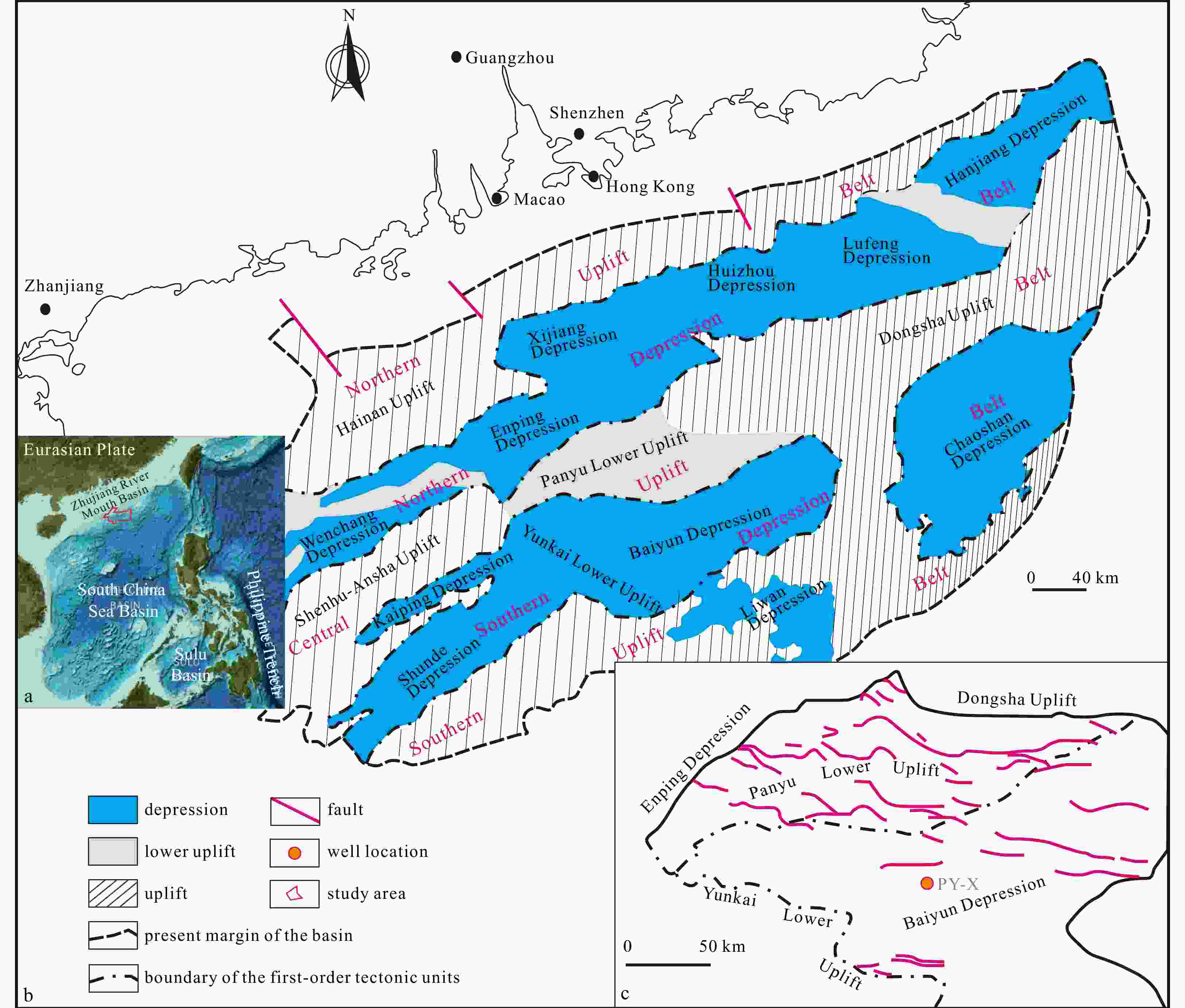
 下载:
下载:

